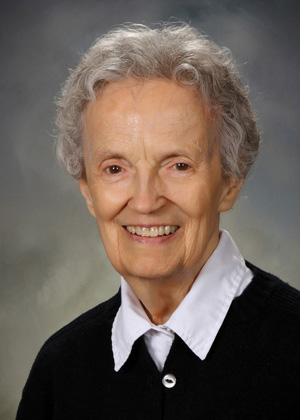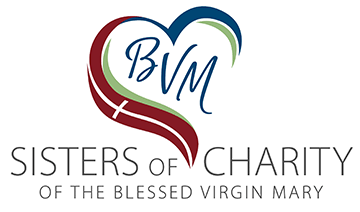Helen Kerrigan, BVM (Paulita)

Helen Kerrigan, BVM (Paulita) died Thursday, Nov. 16,2017, at Marian Hall in Dubuque, Iowa. Visitation will be from 9–10:15 a.m. on Tuesday, Nov. 21, 2017, in the Marian Hall Chapel. A Sharing of Memories and funeral liturgy will immediately follow. Burial is in the Mount Carmel cemetery.
She was born in Davenport, Iowa, on March 19, 1921, to Joseph Patrick and Essie Stella Augustine Kerrigan. She entered the BVM congregation Sept. 8, 1940, from Cathedral Parish, Davenport. She professed first vows on March 19, 1943, and final vows on Aug. 15, 1948.
Sister Helen taught elementary school in Hempstead, N.Y., and Chicago, where she later taught art at Mundelein College. She taught secondary school music and art in Dubuque, Davenport and Marcus, Iowa, and San Francisco and St. Louis. At Clarke University in Dubuque, she was art teacher, department chair, and adjunct professor/artist in residence.
She was preceded in death by her parents; and sisters: Phyllis Kerrigan, BVM (Phileta), Lois Kerrigan, and Alice Kerrigan, BVM (Lois Ann). She is survived by a cousin, Jane Vorhes, West Des Moines, Iowa; and the Sisters of Charity, BVM, with whom she shared life for 77 years.
Sister Helen Kerrigan, BVM (Paulita)
Funeral Welcome
Marian Hall, Nov. 21, 2017
Good morning and welcome to the celebration of life of our Sister Helen Kerrigan.
Helen Rose Kerrigan entered this world on the feast of St. Joseph, March 19, 1921, in Davenport, Iowa, the third child of Joseph Patrick and Essie Stella Augustine Kerrigan. She joined older sisters Phyllis and Lois and was followed by younger sister Alice. “Our family was musical,” said Helen. “We all played instruments and even had a small orchestra. I played violin, and enjoyed this for many years in my religious life . . . [Music] has been an important part of my life.”
Helen graduated from Sacred Heart and Immaculate Conception in Davenport. She completed two years at Clarke University before entering the congregation on Sept. 8, 1940, following in the footsteps of two BVM relatives. Her cousin, Sister Leonilda Kerrigan, entered in 1918 and died in 1978. Helen’s sister, Phyllis (Phileta), entered in 1937 and died on the Feast of the Immaculate Conception in 2007. Three years after Helen entered, her sister Alice (Lois Ann) also felt called to religious life and entered the congregation in 1943; she died in 2006. Helen received the name Paulita upon her reception on March 19, 1941, professed her first vows on March 19, 1943, and lived 77 years as a BVM.
After her profession, Helen taught primary grades at Our Lady of Loretto in Hempstead, N.Y., and at St. Jerome in Chicago, and taught music in Davenport and Marcus, Iowa. In 1946, she was missioned at St. Joseph Academy in Dubuque, where Helen not only taught music, but her favorite subject, art. She taught art at Mundelein College in Chicago for four years and then returned to teaching high school art, this time at St. Paul in San Francisco, and then Xavier in St. Louis.
In 1960, Helen began her long and accomplished career teaching art at Clarke University and occasionally teaching art to novices at Mount Carmel. She designed the original Clarke shield often displayed on podium and graduation rings. She served as department chair from 1967–70.
Helen started painting abstracts, or as she referred to it, “a dialogue with the canvas,” during her early years at Clarke. “Abstract [painting],” she commented, “is a reflection of the times and a most logical development. You don’t suddenly start painting abstract paintings . . . An abstract artist is interested in the formal aspects of art . . . color, line, form and textures.”
Eventually, she returned to realistic painting when her mother suggested that she paint a still life of a jar of marbles. She won a contest with her first marble painting, and continued to paint them. “I like marbles,” said Helen. “Each one is a very individual object that is fascinating and colorful. They’re joyous, I think; I suppose whimsical.” Huge pens and pencils, various cans, candy and Christmas ornaments all became “subjects” in her paintings, but her marble paintings continue to be among her most popular works.
In 1970, Helen experienced the sabbatical of her dreams, spending four months touring the famous art centers of Europe—Italy, Greece, France, Belgium, the Netherlands and London. The highlight of the trip was traveling to Ghent, Belgium, to see an altarpiece entitled “The Adoration of the Lamb,” a triptych by the 15th century painter Jan van Eyck. While describing the occasion for an interview, Helen vividly recalled the entire splendor. “I thought if I ever went to Europe I’d see it – no matter what . . . It’s a jewel . . . It is a great work of art . . . so intricate and in such detail. It glows.”
Helen was a highly accomplished artist, proficient in many styles and techniques, yet she always strived to learn more, to embrace a challenge, to grow in her craft. After her 1999 retirement, she served as adjunct professor at Clarke and later as an artist-in-residence. Art, Clarke and Helen Kerrigan will forever be synonymous.
Many of Helen’s pieces are on display at Clarke and here at Mount Carmel, but nowhere more prominently than in the “Portrait Gallery” on the ground floor of Caritas Center. Among the paintings are a four-generation portrait of Kerrigan women and a portrait of Helen’s father who worked as an assistant conductor on passenger trains.
For a Salt article, Helen wrote, “Finding the connection between spirituality and the arts may take a little time at first. Visual artists in particular will puzzle over such a task. Their experiences with art tend to be practical and down-to-earth, closely connected to material and processes . . . So where is the spirituality? What is the connection? The answer is so obvious—strange that we overlooked it. The spirituality is found where the masterpieces are found. All we have to do is search them out. This is the spirituality then, the magic that happens when you encounter a famous and powerful work of art.”
Helen once commented that teaching art forced her to think through the steps of a project. Her students were not unlike the blind man who called out to Jesus, “Lord, please let me see.” Helen painted what she saw, and tried to teach her painting students to look just as hard. “I try to get them to see,” she said. “I hoped that my enjoyment in making art would inspire them to do the same.” This worked well at Clarke where students could watch Helen drawing or painting during her free time between classes.
Even with failing eyesight in these last years, her enthusiasm for art never dimmed. Often a person of few words, Helen would light up when asked about her paintings and her joy resounded as she described her work. As Jesus gave sight to the blind, her enthusiasm and insights truly opened our eyes, enabling us to see the world in new and wonderful ways. We are forever grateful. Thank you, Helen!
